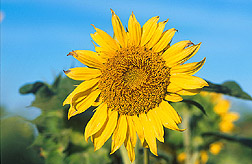This page has been archived and is being provided for reference purposes only. The page is no longer being updated, and therefore, links on the page may be invalid.
Meeting Showcases Anti-Sclerotinia Research
By Jan SuszkiwJanuary 18, 2006
A genomic map, disease-resistant beans and other research achievements are being presented January 18-20 during the sixth annual meeting of the National Sclerotinia Initiative, hosted by the Agricultural Research Service (ARS) in Bloomington, Minn.
Sclerotinia is a fungal disease, caused by Sclerotinia sclerotiorum, affecting more than 400 species of broadleaf plants. Since 2002, ARS has led a multistate, multiorganization effort to counterattack the fungus on three fronts: epidemiology; development of resistance in germplasm; and chemical, biological or cultural control.
The initiative aims to protect seven crops that growers across the country are increasingly including in their rotation schemes: sunflowers, soybeans, canola, dry edible beans, chickpeas, lentils and dry peas. Poor genetic resistance to Sclerotinia in these crops costs up to $280 million annually in degraded quality and reduced yields, notes Larry Chandler, associate director for the ARS Northern Plains Area headquarters in Fort Collins, Colo.
During the meeting, participants from more than 14 universities and 11 trade groups, ranging from the American Soybean Association to the U.S. Dry Bean Council, will discuss the progress to date, as well as identify future research plans and needs through 2009, according to Chandler, the Sclerotinia initiative's ARS coordinator.
Accomplishments to date include development of Sclerotinia risk-assessment maps that dry bean and canola producers can use to implement disease-management strategies; development of dry bean and lentil germplasm lines or cultivars that resist Sclerotinia; uses for the beneficial fungus Coniothyrium minitans as a biological pesticide product; genetically modified soybeans that produce an antifungal peptide against Sclerotinia; and the public release of the sequence for 14,552 of the fungus' genes. The database enables Sclerotinia researchers to search for genes by name, genomic location, their associated proteins and other information.
For more details, as well as recent abstracts, visit the National Sclerotinia Initiative web site.
ARS is the U.S. Department of Agriculture's chief scientific research agency.

